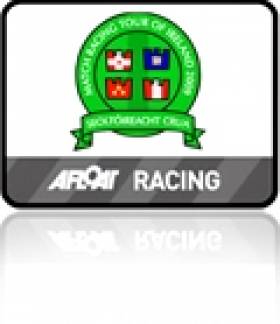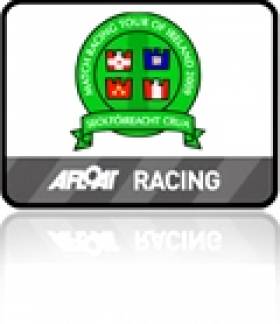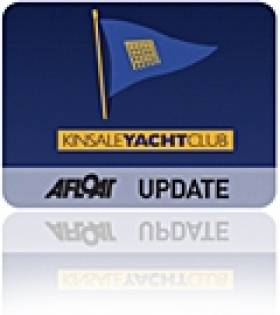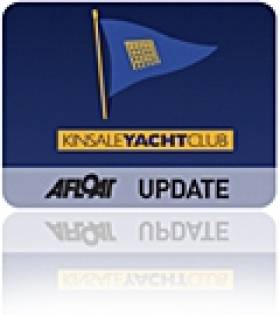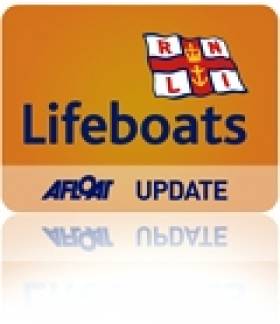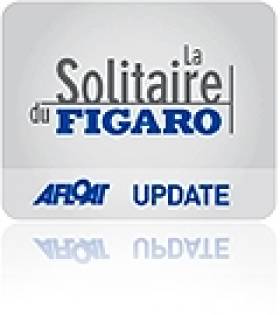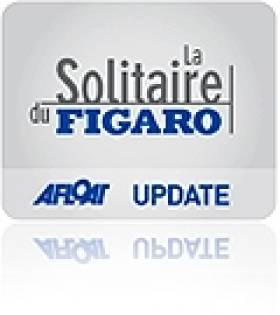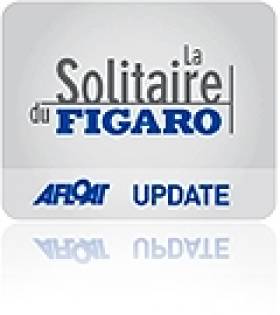Displaying items by tag: Kinsale
Day One Videos from Irish Match Racing Nationals
The Match Racing National Championships are underway in Kinsale this afternoon and we're on the water to bring you vidcasts from competitors at the Round Robin stage. Click read more and listen into George Kingston, Prof O'Connell and Aidan McLaverty.
Vidcasts by Brian Carlin
'Really Naughty' Win First Ever Women's Irish Match Racing Championship
The first ever ISA Women's Match Championship was completed on Sunday, October 10th at Kinsale in Ireland sailing J/80's.
Saturday racing was postponed due to the strong wind gusting up to 37 knots. An early start on Sunday morning, 09.30, proved to of be little deterrent to the ten enthusiastic sailing teams. With no delays between flights each round was completed in under two hours and the schedule was completed in the mid afternoon.

The 'Really Naughty' team with the inaugural trophy in Kinsale
The winners Laura Dillon's 'Really Naughty' team, who were unbeaten during the event, were presented with the 'Kinsale Regatta Cup' by ISA President Peter Crowley. They were followed in second place by Mary O'Loughlin and the 'Ladies Who Launch' team who beat all except the Really Naughty girls. Proving the all-round ability of an ISA bosun Sue Smithwick stepped in when one of the Ladies Who Launch had to be taken ashore for treatment. In a tiebreak on 4 points for third place 'The Sailing West Ladies' of Laura Adamson beat Carol O'Kelly and her 'NautiGals' on 4 points. In their first race one of Audrey's crew decided to try swimming west and test the teams MOB drill. She was promptly recovered by the crew of the boat and completed the day's sailing damp but unbowed. Audrey's team wore their WIMRA T-shirts for the occasion.
The race management team with International Race Officers Alan Crosbie (PRO) and Peter Crowley were busy starting and finishing a race every 12 minutes and there was no rest for the umpire team either with many matches decided by their promptly signalled protest decisions.
This was an ISAF Grade 3 Women's Match Race and all eyes will be on the next World Ranking release on October 27 to see how these teams compare on the world stage.
Final Scores
1 Laura Dillon Really Naughty 8
Crew: Catherine Ennis, Ciara Dowling, Carol O'Kelly, Breffni Jones
2 Mary O'Loughlin Ladies Who Launch 6
Crew: alice cowman, Hazel Ruane, Sam Burrows, Caoimhe Burns, Susan Smithwick
3 Audrey Adamson Sailing West Ladies 4
Crew: Chris Nolan, Michelle Rowley, Emily McManus, Laura Greer
4 Carol O'Kelly NautiGals 4
5 Alice Cowman Launched Ladies 3
6 Chris Nolan West Sailing Girls 2
7 Emma Geary Royal Cork 1
8 Frances Lynch Glandore-Kinsale 1
9 Yvonne Sheehan Emma's Choice 1
10 Choryna Kiely Kinsale Glamour 0
Kinsale Dragon Photos HERE!
Craig Lifts South Coast Dragon Title
Andrew Craig won the first race with the current National Champion Martin Byrne's Jaguar (IRL201) finishing second and Kinsale's Little Fella (IRL211) helmed by Cameron Good and crewed by Simon Furney and Henry Kingston in third.
Martin Byrne with Adam Winkelman and Pedro De Andrade won the final race, their third bullet of the regatta, and Andrew Craig finished in second to clinch the title. Garry Treacy's Dublin Bay (IRL198) crewed by Olympic Star campaigners, his son Max and Anthony Shanks, took third place.
The Royal St George Yacht Club's Andrew Craig was followed by fellow club member Martin Byrne in second place overall with Kinsale Yacht Club's Cameron Good in third and James Matthews in fourth. The George completed the podium with Garry Treacy in fifth and Neil Hegarty in sixth.
At the prize-giving Andrew Craig complemented Kinsale Dragon fleet Class Captain Anthony O'Neill on an excellent regatta.
Overall Standings;
1. IRL192 Chimaera Andrew Craig RStGYC
2. IRL201 Jaguar Martin Byrne RStGYC
3. IRL211 Little Fella Cameron Good KYC
Race 5
1. IRL192 Chimaera Andrew Craig RStGYC
2. IRL211 Little Fella Cameron Good KYC
3. IRL201 Jaguar Martin Byrne RStGYC
Race 6
1. IRL201 Jaguar Martin Byrne RStGYC
2. IRL192 Chimaera Andrew Craig RStGYC
3. IRL198 Dublin Bay Garry Treacy RStGYC
Full results HERE
The 2011 Dragon Irish National and Open Championship will be held at Kinsale, the venue for the 2012 Dragon Gold Cup.
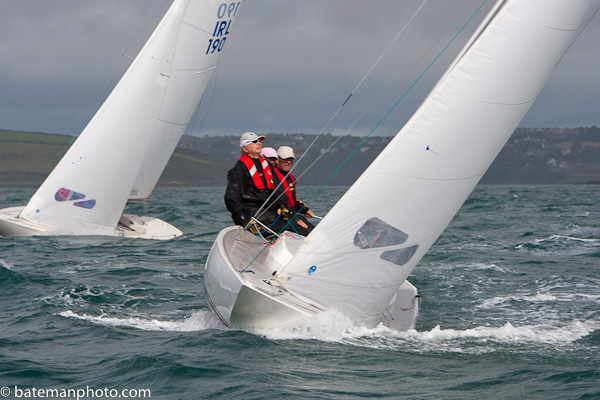
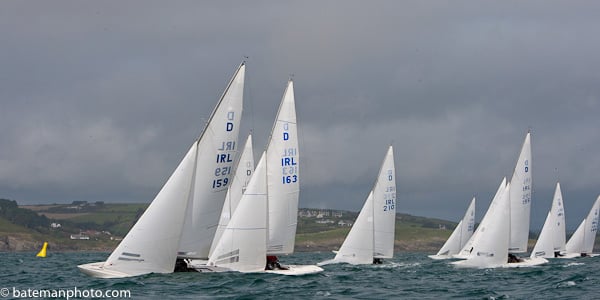
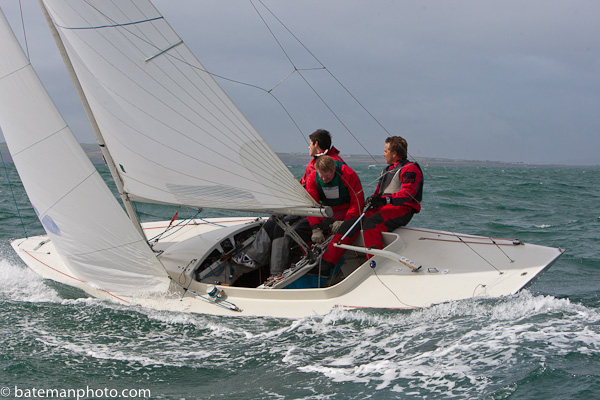
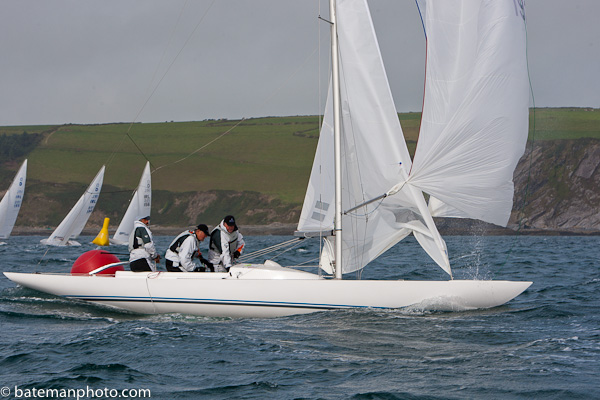
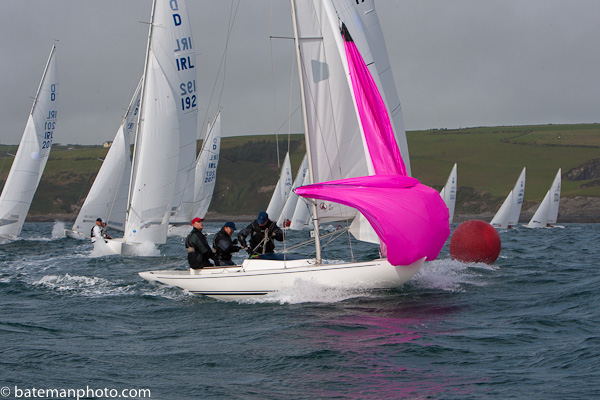
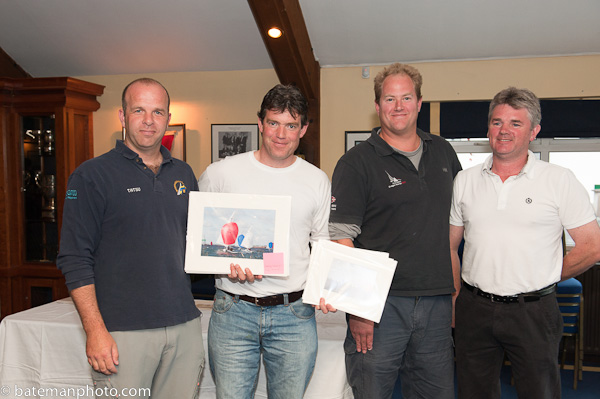
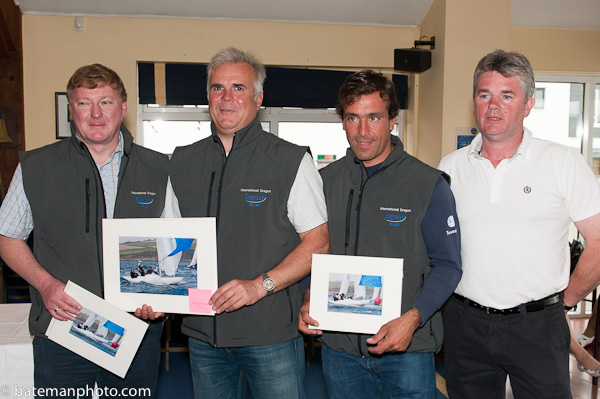
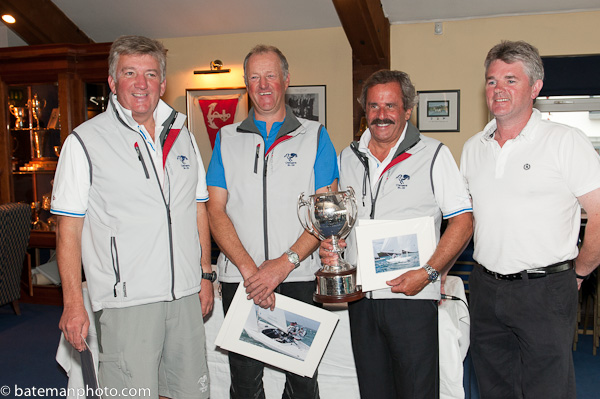
Byrne Takes the Lead in Kinsale
Lifeboat Rescues Two Near Old Head of Kinsale
The Kinsale RNLI Lifeboat was launched at 5.15 pm on Sunday afternoon to go to the aid of a 17ft Mastercraft, with two passengers on board, which had lost power and was anchored one mile east off the Old Head of Kinsale.
Sunday was one of the busiest sailing days of the summer, with very crowded seas. The distressed craft did not have a radio on board. Their only means of contact with shore was a weak mobile phone signal. Thankfully conditions were flat and visibility good, so helmsman Temba Jere and crew members Mark Lewis and Ian Fitzgerald were able to locate the boat and tow it back to the safety of Kinsale Harbour within 40 minutes.
Related Safety posts
RNLI Lifeboats in Ireland
Safety News
Rescue News from RNLI Lifeboats in Ireland
Coast Guard News from Ireland
Water Safety News from Ireland
Marine Casualty Investigation Board News
Marine Warnings
Figaro Start Pics from Kinsale
Under a grey sky the 44 skippers taking part in La Solitaire du Figaro, left Kinsale for the fourth and decisive leg. Tension was high and the Committee was forced to give two general recalls. Swiss Bernard Stamm (Cheminée Poujoulat) and French Matthieu Girolet (Entreprendre) were involved in a collision and suffered from serious damages to their boats. Both decided to abandon racing.
Excellent start for young Portuguese Francisco Lobato and Italian Pietro D'Alì. Weather conditions are expected to be fairly tough, for a fast 435 miles passage to the finish in Cherbourg. A lot is at stake, for the leaders as for each one of the competitors to the 2010 Solitaire and tension builds easily. That is especially the case at the start of the last and decisive leg. And today the 44 skippers were eager to leave Ireland, apparently. So much that the Race Committee was forced to hoist the general recall flag twice before getting a clear start. And, it was when tension ran so high that between the first and the second start that a violent collision occurred involving Swiss Bernard Stamm (Cheminée Poujoulat) and Matthieu Girolet (Entreprendre).
As boats suffered from serious damages to their hulls both skippers decided it was not safe to continue racing and abandoned the Solitaire. Stamm's Figaro had a conspicuous hole on the bow and despite all the other competitors' shore teams immediately started working on it in a solidarity effort, the damage was too extensive to be repaired in a reasonable amount of time. Girolet's breakage was equally evident, and he also reported to have some parts detached inside the boat and doubted also that the rigging was still efficient. Stamm will be given a DNF in the final ranking which means the last's time plus two hours.
Racing continued for the other 42 skippers, who, before heading offshore had to sail a windward/leeward course between the Seamobile and the Radio France Marks, with a good breeze of 10 to 12 knots. Racing was very close and intense and gaps reduced to a minumum. At the Radio France Mark, located near Bulman, it was Laurent Pellecuer (Arnolfini.fr <http://Arnolfini.fr/> ) to round in first, very closely followed by Jean Pierre Nicol (Bernard Controls) and by a brilliant Francisco Lobato (ROFF/TEMPO-TEAM) who showed very good speed under spinnaker.
It was then the turn of Jérémie Beyou (BPI) and Yann Eliès (Generali Europ Assistance). Behind them boats arrived grouped together, creating a pretty confused mass with more collisions and protest flags. The other non French sailors were Pietro D'Alì (I.NOVA.3) in 11th, Jonny Malbon (Artemis) in 15th and Isabelle Joschke (Synergie) in 27th. Competitors will now have to sail along the Irish coast to reach the famous Fastnet lighthouse that lied 45 miles away, leaving it to port side. The leaders should get there around midnight. According to the weather forecast by Météo France's expert Sylvain Mondon, after having rounded the Fastnet on their way to Lizen Ven, the fleet will encounter stiffer NW breezes topping 25 with gusts over 30 knots.
Quotes form the skippers:Bernard Stamm (Cheminée Poujoulat) "The accident was quite unfortunate. I heard on the VHF that the Committee was announcing a change of the pin end, I was trying to find a right spot to check and all of a sudden I saw Matthieu's transom. It was too late, there was nothing I could do to avoid the crash. I was sailing pretty fast, 6 or 7 knots, ballasts full and couldn't change my course. It all happened in seconds. It was a big, loud crash. It's a pity, I'm really sad and disappointed." Matthieu Girolet (Entreprendre)"I'm really sorry, it was my fault no doubt about it (he was sailing on port tack when the accident occurred ed. note). I couldn't see Bernard coming because I was paying attention to the many spectator's boats around, trying to avoid them and did not see Bernard coming. I should have because I was on starboard tack. I definitely can't start again, my boat is badly damaged, I guess it would be unsafe and uncosiderate. We fight and train all year long to be in the Solitaire and it is just sad, disappointing, to be finishing like this."

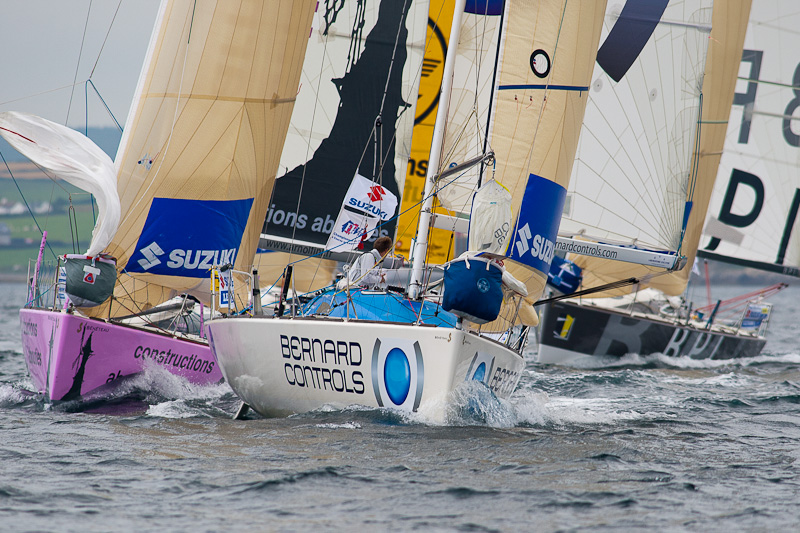
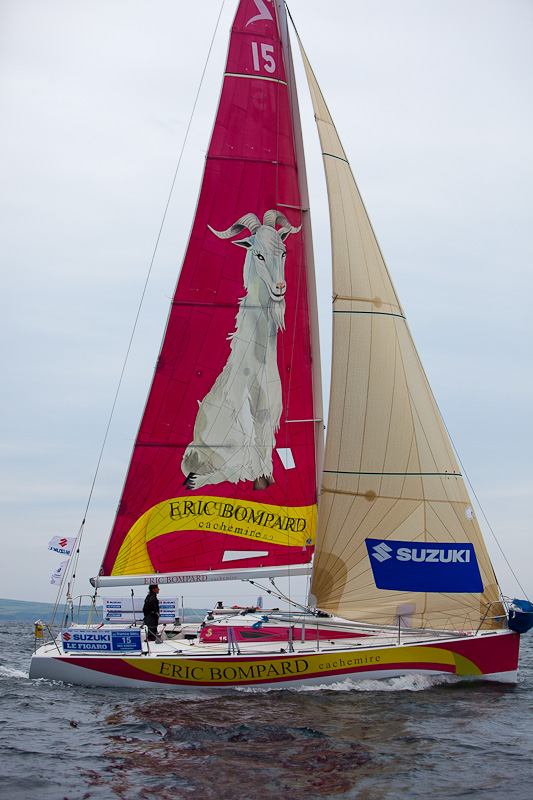
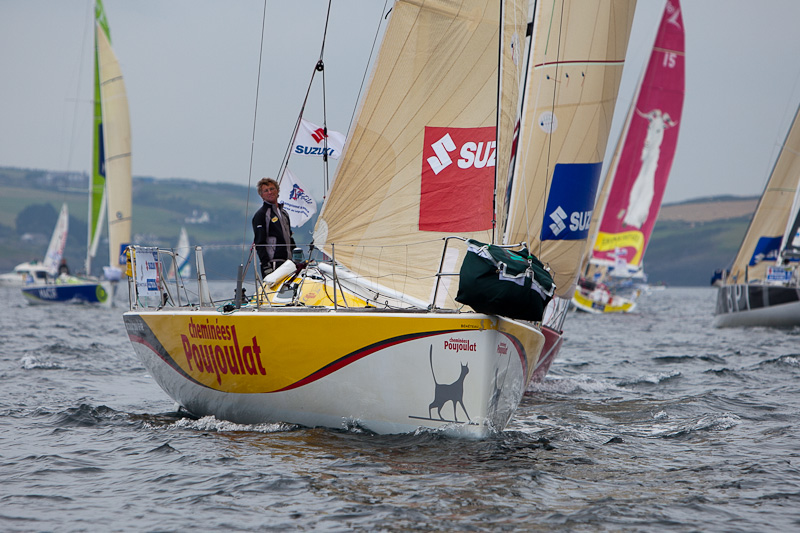


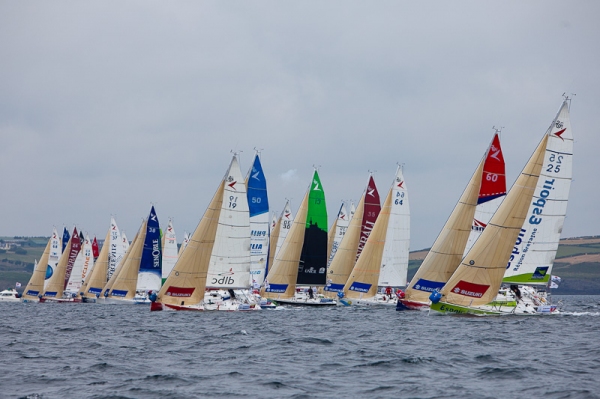
Preparing for La Solitaire du Figaro here
Latest news for La Solitaire du Figaro hereAfter a general recall a 'violent collision' occurred during the build up to the second start between Swiss Bernard Stamm (Cheminée Poujoulat) and Matthieu Girolet (Entreprendre).
The collision was as a result of a port and starboard incident.
As both boats suffered from serious hull damage both skippers decided it was not safe to continue racing and abandoned the Solitaire.
Stamm's Figaro had a conspicuous hole on the bow (below) and despite all the other competitors' shore teams immediately started working on it, the damage was too extensive to be repaired in a reasonable amount of time.
Girolet's breakage was equally evident, and he also reported to have some parts detached inside the boat and there was doubt the rig was still intact.
Stamm will be given a DNF in the final ranking which means the last's time plus two hours. Racing continued for the other 42 skippers, who, before heading offshore had to sail a windward/leeward course between the Seamobile and the Radio France Marks, with a good breeze of 10 to 12 knots.
Bob Bateman's photographs of the damage to the Swiss boat, Bernard Stamm (Cheminée Poujoulat) is below:

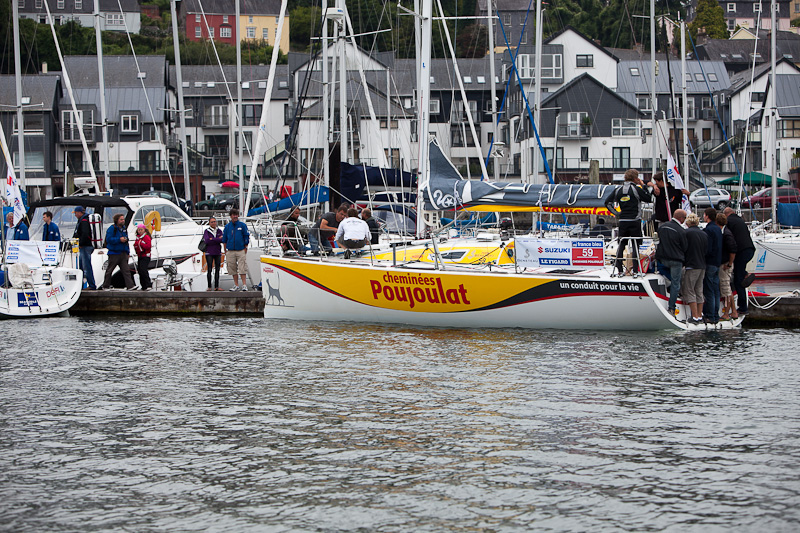
Preparing for La Solitaire du Figaro here
Latest news for La Solitaire du Figaro hereFigaro Race Departs Kinsale at 1pm Today
The fourth and decisive leg of 2010 La Solitaire du Figaro will start from Kinsale tomorrow at 13.00. The 44 skippers will have to deal with the last 435 miles to Cherbourg and weather conditions are expected to be fairly tough, for a fast passage to the finish. Armel Le Cleac'h is still solidly in the lead but his competitors will surely play their cards right to be on the highest step of the podium.
Rule one: good manoeuvres and no breakages. The long stopover in quiet and friendly Kinsale is nearly over, after resting, enjoying the scenery, the hospitality or some golfing or fishing, the skippers get ready to leave for the last lap to Cherbourg.
To leave Ireland, the competitors will once more have to sail along the Irish cost to reach the famous Fastnet lighthouse 45 miles away, leaving it to port side. As opposed to the third leg, the 250-mile leap across the Celtic Sea will see the fleet leave the Scilly isles and the imposing lighthouse of Bishop Rock to port side. The skippers will have to negotiate the cross currents common to the English Channel for more than 100 miles, their waypoint set precisely on the cardinal buoy West Lizen Ven north of the île Vierge. After this mark, to be left on port side, the fleet will set off for 140 miles towards the Channel Islands. But this time, only the île d'Aurigny will be left offshore.
Like it happened for their way up to Kinsale, overtaking the islands of Guernsey, Herm and Jersey will require all the skipper's fine strategy. Later on, there could be some good options or tactical chances nearer to the Cotentin coastline.
The Raz Blanchard could open up the game over the last miles to the finish in Cherbourg-Octeville, will host the grand finale of La Solitaire du Figaro. As tradition the 44 skippers will meet late afternoon for the briefing, to get the last details on the weather they will encounter and routing to deal with the 435 miles that separate them from Cherbourg and the final verdict on who will win the 2010 edition.The fight looks fiercer than ever: if Armel Le Cleac'h (Britair) can count on a solid lead on his two immediate competitors, François Gabart (Skipper Macif 2010) and Tomas Rouxel (Credit Mutuel de Bretagne) nonetheless he will have to watch out for at least ten sailors who can well play a master stroke and obliterate their disadvantage. Same can be said for the "bizuth", the newcomers category, where Anthony Marchand (Espoir Region Bretagne) has slightly more than 18 minutes on Yoann Richomme (DLBC) and 56 minutes on Swiss Bernard Stamm. Easy to predict very close, tactical, racing for them.
According to the weather forecast by Météo France's expert Sylvain Mondon, after having rounded the Fastnet on their way to Lizen Ven, the fleet may encounter, and have to tackle with accordingly, two different meteorological outlooks: one with lighter northwesterly winds blowing at around 15/20 knots and one with stiffer breezes topping 25 with gusts over 30 knots. Maximum focus and eyes wide open together with faultless manoeuvring will be needed, since a badly conducted gibe or a broken spinnaker may involve significant time gaps on the finish line, loosing or getting many positions in the general ranking. As confirmed by Race Director Jacques Caraes: "It will be physical, very tiring and skippers will have to steer a lot. No mistakes allowed there.
The leg will be probably faster than expected and we could finally have a finish in daylight."As a matter of fact the leaders could well reach Cherbourg, where the Solitaire comes back for the seventh time in its history, Wednesday around midday or Thursday at the latest should the wind be lighter. The approach to Cherbourg will be nonetheless a tricky one because of the strong tidal flows and currents that could be as strong as 3.5 to 4.5 knots. Quotes form the skippers:Romain Attanasio (Saveol) "We'll sail fast, under spinnaker and it looks like there won't be light airs. There is not a big tide coefficient so we don't expect an awful lot of current at the raz Blanchard. Yet, we will have to play with a cold front. I had a similar experience and it was a pretty busy time: people going into the low and others who trail behind and at the finish it was... 20 miles. This leg does not worry me more than the others, there will be much spinnaker downwind sailing and I feel at ease with that. I'm not afraid but I know that it will be necessary to be in front from the start. The risks? Breaking a spinnaker would mean disaster." Gildas Morvan (Cercle Vert)"It will be a fast one, there's wind the route is straight.
Not much to think about, it will be breezy, a low to deal with and it looks like we won't sleep too much, it's not going to be very relaxing, that's for sure. Helming and manoeuvring... I like the idea. You can get or loose time easily, the main thing is not to break anything, to gibe well, watch out for the cargos' route, because we will get to the finish in a dash under spinnaker..." Anthony Marchand (Challenge Espoir Région Bretagne) "I did my navigation session earlier, I'm downloading the latest weather grib files to make some simulations. I've had three bad starts and I know I can't have another one... after that is fast downwind, there will be wind but not so much. If it's downwind, even in 25 knots, on a Figaro you don't really realize.
It's one of those legs that may seem easy because you're going straight to the target but then the small lateral gaps when you get to a waypoint can make a difference. I have the impression that there is more difference among us on windy legs, at least this is what I feel. I'm less stressed than I was at the beginning, when I felt like going to a new school not knowing if the schoolmates would be nice. At the end the teachers are nice and the mates too..." Jonny Malbon (Artemis)"Kinsale is a beautiful place with very friendly people and we've been pretty lucky with the weather. Ready to go now, for me I've got to have a good leg cause although being quite close in the last leg it was pretty disappointing to be right down at the back of the fleet. Given the level of the fleet, you just make one mistake and it's difficult to get back in. So, I've got to focus, I've got nothing to loose just go full power and try to do my best, be in a good position and a good result in Cherbourg. Fingers crossed the weather looks ok, we should see some good speed downwind and fleet racing. We won't be having much sleep because you have to be more on form with the boat."
Preparing for La Solitaire du Figaro here
Latest news for La Solitaire du Figaro hereKinsale Yacht Club Hosts a Crowded Prize Giving Ceremony
During a very friendly and informal ceremony, (Click HERE for photos by Bob Bateman) Kinsale Yacht Club’s Commodore Alice Kingston welcomed back the La Solitaire du Figaro fleet after 12 years’ absence and said that she hoped her hometown will keep its record for the location who hosted the highest number of stopovers intact. Commodore and Race Director Jacques Caraes exchanged mementoes. François Gabart (Skipper Macif 2010) received a cheque for being first at the Radio France mark in Brest, Thomas Rouxel (Credit Mutuel e Bretagne) got the GMF Assistance prize for his lead at Wolf Rock, Gildan Morvan (Cercle Vert) who, during the leg went up 40 places recording the best progression between the Radio France mark ad the finish was given the CLS prize.
Anthony Marchand (Espoir Region Bretagne) who crossed in first among the newcomers, the so called “bizuth” category, by only five seconds in front of Portuguese Francisco Lobato (ROFF/TEMPO-TEAM) received a check worth 800 Euros from Bénéteau. It was then the turn of the three skippers that got on the podium: third placed Jean-Pierre Nicol (Bernard Controls), Yann Eliés (Generali Europ Assistance). Finally, a radiant Adrien Hardy (Agir Recouvrement) received the prize for his first ever leg victory. During the ceremony a special award, consisting of a bottle of wine, was also presented to yesterday’s golf tournament winner Jimmy Pahun by race’s veteran Jean-Paul Mouren.
Tomorrow will be the last day for the 44 skippers to get ready for the last, and in many cases decisive, fourth stage of the 2010 edition of la Solitaire, from Kinsale to Cherbourg for a total of 435 miles. Quotes form the skippers:Adrien Hardy (Agir Recouvrement): winner of the third leg on receiving his prize“I’m over the rainbow for this victory, it’s such a weird a positive feeling to win a leg in the Solitaire, especially at the end of such a hard and fought for race. Thanks to my competitors for the support and the nice words they had for me, their respect is a prize in itself.”
Preparing for La Solitaire du Figaro here
Latest news for La Solitaire du Figaro here


























